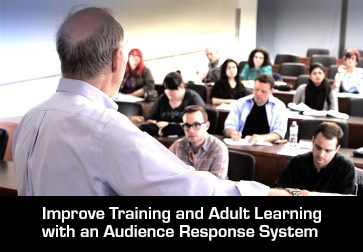
Have you ever sat through a training presentation and thought that you learned more from staring out the window than from the instructor? Unfortunately, this scenario is common among adult learning presentations.
Many face to face training presentations are not optimized to maximize relevance and impact on audiences. The typical presentation consists of one or two presenters, usually having spent large amounts of time and effort developing the instructional design and content. All too frequently, this occurs without any assessment of learner needs, the existing skills in the learning population, or the results of previous training programs on the subject.
With an audience response system, this can change. Learning professionals can use the system to quickly and easily prepare questionnaires and assessments to measure learning needs, reactions, and results before, during, and after learning interventions.
Needs Assessment
With an audience response system, an instructional designer can more easily prepare and administer a questionnaire to assess the needs of the target group of learners. This can include measurement of existing skill or knowledge levels along with perceived priorities for next steps in growing competency and on-the-job effectiveness.
Questions are authored and administered in PowerPoint using multiple choice, scalar, or open-ended text input questions. Sample groups of learners complete the surveys very quickly using hand-held keypads, smart phones, tablets, or computers. Response rates are typically higher than web or email-based surveys, and learners enjoy the process of engaging in and providing information. Results from survey data-gathering sessions flow into the response system database for immediate reporting and analysis.
Presenters or instructional designers can gauge the learners’ baseline knowledge more quickly and easily by administering a pre-test with an interactive system. In many cases, the assessment question results from previous instructional sessions can serve as the “pre-test” data pool to help design the next instructional presentation.
Evaluating Effectiveness by Measuring Reactions
Paper evaluations, “smile sheets,” and web surveys are established best practices among learning professionals. However, these formats can be difficult to administer and result in low response rates with insufficient actionable data. Using an interactive response system reduces or eliminates many of the hassles of traditional evaluation tools. Presenters can add evaluation question slides to the end of their instructional slide deck and pose questions to gather feedback data in real-time. Response rates typically exceed 90% and results are more valid because the session is fresh in the minds of attendees. Results have higher validity with higher perceived anonymity allowing all participants to have an opportunity to respond in seconds.
Audience response systems allow instructors to test the baseline knowledge of participants in order to ensure that instruction is best suited for learners. You can avoid making your presentation too easy or too difficult to understand, and you can engage your learners at the pace that they need in order to progress at an optimal pace.
Testing and Assessment
Using an interactive response system, instructors can pose and tabulate test questions before, during, and after sessions. This allows for adjustment to the instructional design to include remediation loops if the group is failing to grasp a particular concept. It also provides for immediate tabulation and demonstration of results with pre-post comparisons.
Measuring Application of Skills and Knowledge
Learning programs have little value if participants don't apply the new knowledge or skills on the job. Often, data collection after the learning intervention is difficult to obtain and analyze. Using an audience response system makes it easier to administer questionnaires two to six months after the conclusion of a program. Facilitators can gather program participants, co-workers, or supervisors to ask critical questions that measure application of new skills or knowledge.
With audience response systems, participants provide honest answers. Response rates are high and data is more often more useful because interactive systems provide survey respondents with greater confidence that they are responding anonymously. This reduces fear of reprisal and helps to boost the validity of survey data.
Response systems allow you to evaluate how well learners have retained new material and how they are applying it on the job. This crucial evaluation process delivers the answers you need in order to determine how effective, skilled, and safe your workers are.
Measurement has never been easier in adult learning. Keeping an eye on how your program participants are responding with an audience response system can be a powerful way to make sure that training programs are effective and relevant to the needs of learners and the organization.
For more information on how you can improve your training programs, please click the button below!


